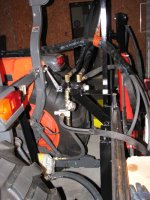Joee
Member
Hi,
I have a 20 gpm Prince relief valve, between a 21 gpm pto pump
and motor controller, there is also a 3000 psi gauge after relief
valve.
My question is I'm not sure about how to adjust relief valve. With
pto engaged and turning about 540 rpm, all the pressure I can get
at the gauge is between 500 & 800 psi. This is no load pressure
and I am turning adjuster on relief valve.
The Prince relief valve has an adjustable range of 1000-2500 psi.
Advise needed, Joe
I have a 20 gpm Prince relief valve, between a 21 gpm pto pump
and motor controller, there is also a 3000 psi gauge after relief
valve.
My question is I'm not sure about how to adjust relief valve. With
pto engaged and turning about 540 rpm, all the pressure I can get
at the gauge is between 500 & 800 psi. This is no load pressure
and I am turning adjuster on relief valve.
The Prince relief valve has an adjustable range of 1000-2500 psi.
Advise needed, Joe



